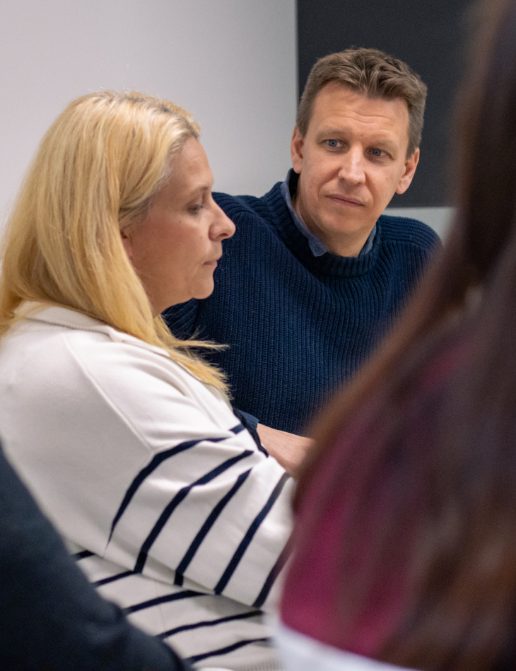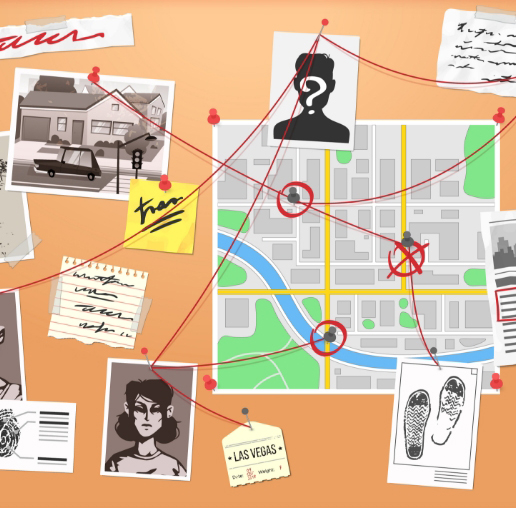

See how we brought health and safety training to life with a strong detective story.





We all love a great whodunnit at Christmas. Whether it’s digging into a classic Sherlock Holmes mystery, watching Kenneth Branagh or Daniel Craig solve a complex series of clues or tuning into the latest Death in Paradise Christmas Special to get your yearly dose of sun, sea and suspicion! Well, this year, Waitrose’s advert, ‘Sweet Suspicion’ takes well-known detective story tropes and the spirit of your favourite board games and transforms them into a star-studded, captivating drama – leaving us all to work out who ate the dessert.
And, what’s more they didn’t tell us straight away! We had to wait a while to find out who the dessert thief actually is, watching a series of social media diary-room videos, alibi reveals and social activations to piece the clues together before the big reveal.
Watch the ad below:
Pretty good, no? Perhaps you’re now joining in and trying to work out who the most likely culprit is? Me too!
So, what can we actually learn from a Waitrose Christmas advert, a cat accused of robbery and the drama of a good detective story? And what on earth does this have to do with digital learning, performance enablement and learner engagement? Grab a mug of hot chocolate (or mulled wine), sit back and see how to take your learning to the next level.

Let’s start with the drama of it all. That’s what makes this campaign stand out from the crowd, break through the noise and truly engage audiences. We’re used to a sea of fairies, sparkles, snow and food from supermarket Christmas adverts, so why did Waitrose decide to switch things up with thrilling detective drama? Exactly because their customers felt Christmas advert tropes were overused and undereffective.
So, as Waitrose customer service director, Nathan Ansell says, they, “wanted to do something a little different” and shake the metaphorical Christmas tree. But the campaign isn’t just effective because it’s different! Yes, that makes it memorable, but different doesn’t necessarily mean better, does it? It’s the excellent storytelling and theatre that make it the best of the bunch this year.
A good story, when told properly, can engage audiences like nothing else, as they buy-in to the characters, hang on every word, twist and rabbit hole, and ultimately itch to find out what happens in the end. A strong narrative is always more compelling, and a touch of drama attracts and inspires like nothing else.
Take the new hit BBC detective drama, Ludwig. This unexpected gem has been one of the most successful and enjoyable shows put out by the BBC in recent years—even scoring a perfect 100% on Rotten Tomatoes. Why is this? Because the characters, story and drama of it all are well-crafted, relatable and captivating. Plus, the story is full of twists, turns and plenty of big reveals! It’s a pretty simple recipe, but hard to execute right every time.

We could all learn a thing or two from this campaign. Think about it, Waitrose have listened to feedback from their customers, switched up their advert to better engage them, and employed a strong narrative to tie everything together. Why shouldn’t we be doing the same with our learning programmes?
Most of your learners will probably have seen a lot of learning, digital or otherwise, in their time and believe me, they’ll have some strong opinions on it too. So, speak to them, listen to their thoughts, find out what they liked, what they didn’t like and why. This is the best place to start when deciding how to approach learning in the future.
Yes, different topics and objectives will require certain formats or approaches, but if you want your training to truly connect with, resonate with and inspire your audiences, you need to put in the time to understand what works for them.
And, once you have a clear understanding of what you’re trying to do and how you’re going to do it, think about the narrative you want to create. This doesn’t just mean scripting well-structured scenarios to demonstrate concepts in action (but do definitely do that!), it also means creating strong hooks, benefit statements and calls to action for every piece of training you design.
It’s really important that your learners understand what you’re asking them to do, why you’re asking them to do it (i.e. the benefits to them and the benefits to the business) and what you want them to do with the information, knowledge or skills they’ve gained during the programme.
Think about it, the ultimate aim of the Waitrose advert isn’t to win a BAFTA for best TV drama, it’s to get people into their shops, buying their products.
Your learning shouldn’t just look and be great, it should inspire action!


See how we brought health and safety training to life with a strong detective story.
In recent years, and challenging economic times, the competition among food retailers to attract customers has become even more fierce than before. One way that Waitrose (along with other supermarket retailers) have tried to combat this is to increase the variety of touchpoints and channels used to connect with their audience – and reach new audiences.
The retail giant has been growing its use of social platforms, like TikTok and Instagram, and leaning on a less serious tone of voice (an approach becoming more popular with other B2C companies, such as Currys), with their social media reach up about 40% year-on-year, alongside TV sponsorships and adverts. This is a very deliberate move to target customers of all ages in the places where they consume content
And their Christmas advertising campaign is no different!
It uses a combination of TV advertising, short-form, social media content and sponsorships with comedians and celebrities to get the word out and keep pushing its brand and messages. It’s a true, multi-format, multi-impact campaign.
It’ll come as no surprise that the engagement challenges explored above are not isolated in the food and retail industry, but actually apply to the work carried out in L&D. Because, we too have to fight for the attention of learners, battling against competing priorities like doing their job, browsing social media or their personal lives, as well as large amounts of corporate noise, to deliver impactful training.

One of the most common challenges (or mistakes!) we hear about when speaking to our clients is that they go through the long process of creating a great piece of learning, only for it to get lost in the depths of their platform. This problem stems from the assumption that learners are as engaged with learning as you are – they’re not!
It’s time instead to think about how to effectively reach your audience. Whether that’s advertising a new module on internal social platforms (email, MS Teams, Slack) or creating an entirely campaign-based programme, find out where your audience is and go to them, rather than waiting for them to go to you.
It’s also a good idea to gain sponsorship and buy-in from notable people in your business. Why not try to get senior leadership engagement or assign champions to promote your learning and objectives across the organisation? This will only increase your impact and help solve your awareness challenges.

PS, at Dynamic, we love everything digital-based (shock!) and strongly believe in the effectiveness of multi-media, multi-format learning. Why not create a video to promote your learning? How about arranging a live webinar to answer FAQs and address concerns? Or providing a digital toolkit with performance support materials?
In a world where content overload is a very real problem, design yours with purpose, intent and your learners in mind.


The audience of ‘Sweet Suspicion’ are invited to actively participate in the unveiling of the story. One of the most-loved aspects of a whodunnit is the winding trail of clues, red herrings and plot twists that leave you guessing right up until the very end. It’s a clever approach that doesn’t just present something to the audience, it makes them a part of the action, as they try to decipher the case as a detective would in their favourite show. And it’s safe to say that one viewing is definitely not enough to solve the mystery—or is it?
It’s widely accepted that a good learning experience should be active and not passive. Whether it’s in the way a learner selects their pathway through a programme, or by asking someone to engage with a series of tasks, activities or interactions, people simply learn better when they feel like they’re a part of the decision-making process.
When we design an activity or a module, we often think about how long it might take someone to complete it – after all we need to think about the seat time and the cost of the overall course. But the best experiences are those that leave people coming back for more. Why not include small details in your training videos that people might miss the first time around? How about providing feedback on their decisions in adaptive scenarios and letting them have another go?


This can feel pretty unusual to begin with, but this is where the most productive learning can happen. It’s all about safe practice and iteration in the learning process. Let them fail and try again before they have to put what they’ve learned into practice in their roles. After all, if they make a mistake in a controlled environment, no one else is going to die. It’s not a murder mystery after all!


Learn how we used emotive storytelling to explore the impact of damp housing for Riverside.
Now, what about the social aspect of the campaign. Yes, every great advert has people talking about it to their friends and family, that’s a marketers dream. But this campaign goes a step beyond. It encourages discussion, deliberation and even possibly disagreement over who different people think the prime suspect(s) is.
They even use a clever piece of social activation to kickstart the conversation, filming two well-known actors from BBCs Line of Duty (Martin Compston and Vicky McClure) as they argue over whodunnit in an all too familiar setting, on the sofa in Christmas jumpers. This might look like just more drama to add to the story, but it actually invites the audience to do the same by jumping in the comments, sharing the video or, as in the clip, chatting about it on the sofa with their friends.
There certainly is! Social learning and active discussion can significantly enhance the transfer of learning to the workplace. It’s an age-old format employed by universities (through lectures and seminars) and training instructors to present content, encourage group discussion and create opportunities for collaboration.
Social learning, whether it’s breakout rooms in webinars, team development projects, or dedicated discussion forums, is a valuable tool for sharing ideas, seeking and providing assistance and creating a shared learning experience. It’s a step towards the natural transference of knowledge that every workplace dreams of.

Ready to find out who ate the pudding? Watch the big reveal below:
Did you guess the culprit, or did you fall for a red herring?
The point is, right up until the end, this clever Christmas campaign had you guessing!
There’s lots of lessons that L&D can learn from marketing, detective stories and an innovative Christmas campaign like this one. So, as you start to think ahead into 2025 and beyond, and probably set a few unrealistic targets and resolutions (good luck with dry Jan!) make a commitment to shaking things up, doing something new and taking your learning to the next level.
Tell a story that resonates with the people across your organisation, reach your audiences where they are using different communication channels and digital learning formats, and actively promote engagement and collaboration in the learning process.
I’d say that’s a good place to start and more than just a stocking—or a time—filler.


Want to add a bit of Christmas magic (or all-year-round magic for that matter) to your digital learning? We ho-ho-hope you know where to come.
Merlin Entertainments create and deliver memorable, immersive brand experiences for over 60 million guests a year. Dynamic created gamified elearning to ensure that individual engineers’ and ride operators’ expertise was transferred to new colleagues around the globe.
“Working with Dynamic has been a great partnership.”
Nicola Maisuria | Health, Safety, Security Director

